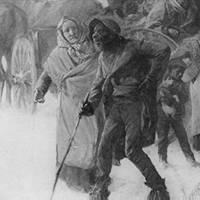The Underground Railroad is a catch-all term that refers to any of a large number of methods that American slaves and those sympathetic to them used to help those enslaved in their flights to freedom before and during the American Civil War. The Railroad wasn't necessarily a train route, although it was in part for many escaped slaves. It wasn't necessarily underground, although many underground tunnels and hiding places were used to shield runaways from slave-chasers. It was, for a great many people, a way to escape the evils of slavery. The term is known to have been in use by 1840, although it is certain that people had been escaping from slavery long before that. As is often the case, historians often point to one instance as the first use of the term: Supposedly, the term was first used by the owner of Tice Davids, an African man who fled slavery in Kentucky by crossing the Ohio River. The owner tracked Davids to the river, where the enterprising Davids disappeared without a trace. The man chasing him remarked that Davids had "gone off on some underground road."
The Railroad had no one designated route. That would be too easy for slave-chasers to figure out. Rather, those who operated and traveled on the Railroad chose routes and methods of escape that were most likely to evade capture or recapture. Some examples:
People who belonged to the Society of Friends were called Quakers. They were morally opposed to slavery in any form. Many Quakers were part of the abolitionist movement, and many also helped runaways escape. People who helped slaves escape by feeding In dangerous times, runaways found it difficult to know whom to trust. Those who helped on the Railroad often identified themselves covertly if at all. Lanterns hung on lamp posts or in certain windows shone the way to help for runaways, identifying "safe houses." (Of course, slave-catchers wised to this practice eventually and caught many a runaway by posing as a "helper.") Next page > Prices of Freedom > Page 1, 2, 3 |
|
Social Studies for Kids
copyright 2002–2025
David White



 The Underground Railroad was much more in the public eye in the American North than it ever was in the South, mainly because many more people in the North were sympathetic to the interests of runaway slaves. Also, the destinations were not always in the North. Many slaves escaped to other points on the compass: to western territories, to Mexico, and to the Caribbean.
The Underground Railroad was much more in the public eye in the American North than it ever was in the South, mainly because many more people in the North were sympathetic to the interests of runaway slaves. Also, the destinations were not always in the North. Many slaves escaped to other points on the compass: to western territories, to Mexico, and to the Caribbean. them and giving them shelter for a night were said to have "safe houses."
them and giving them shelter for a night were said to have "safe houses."
